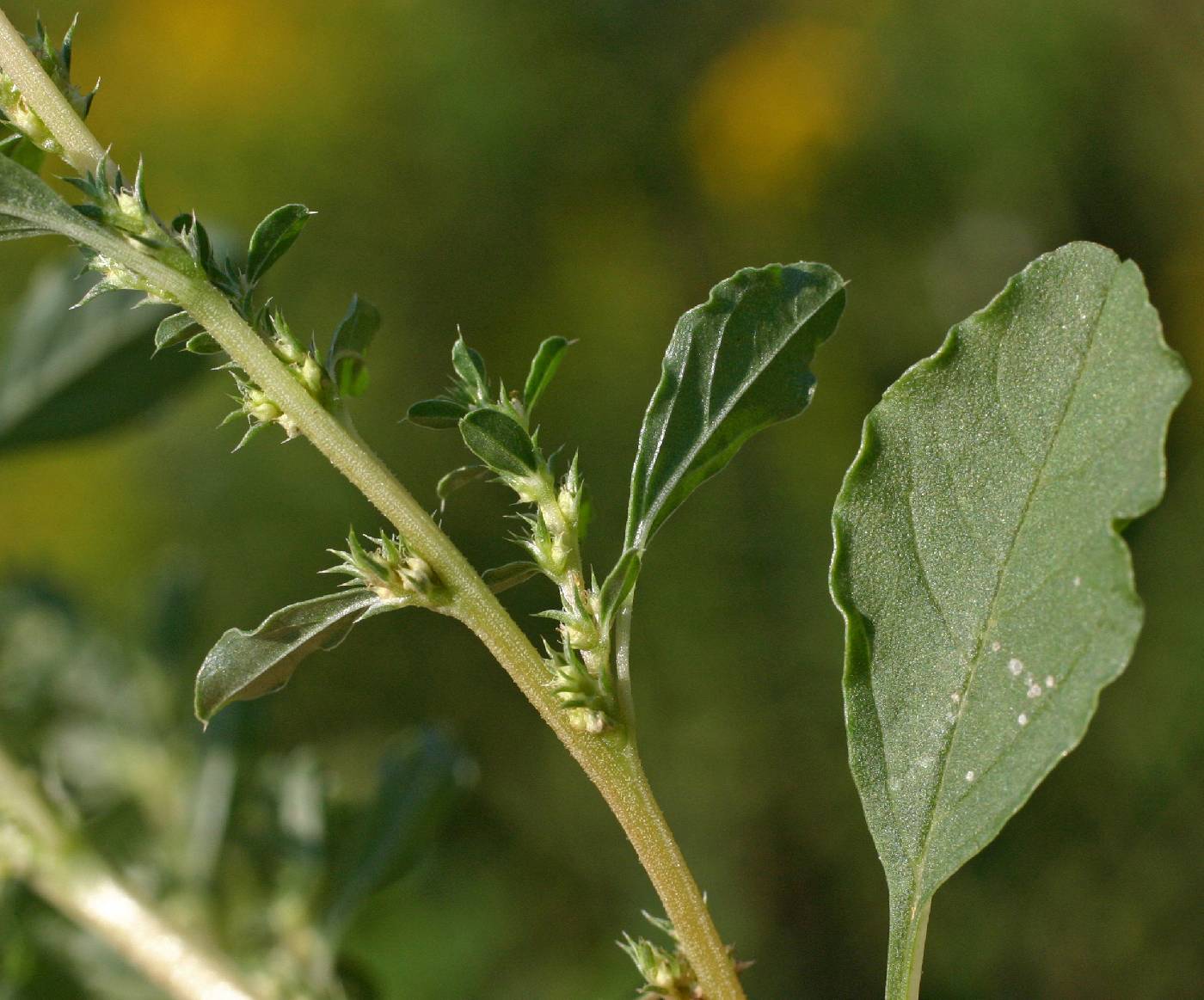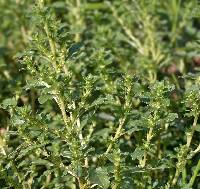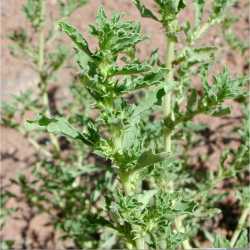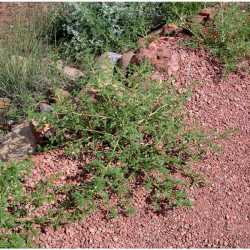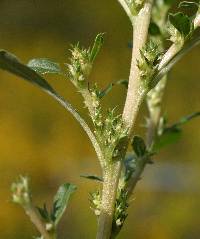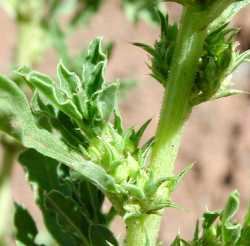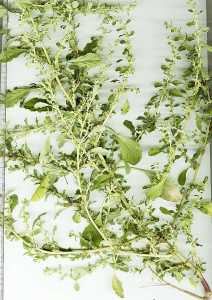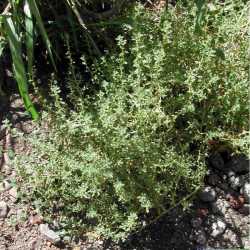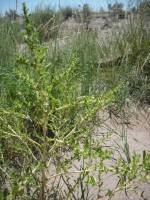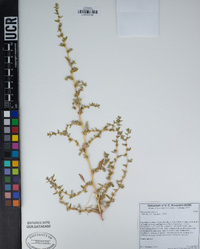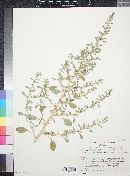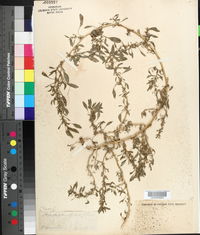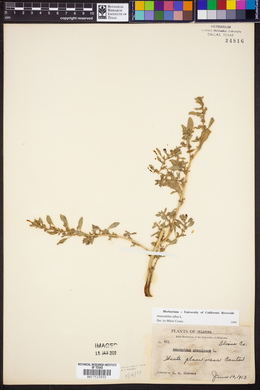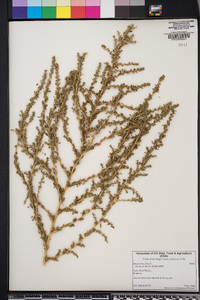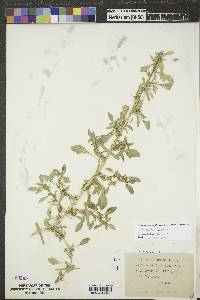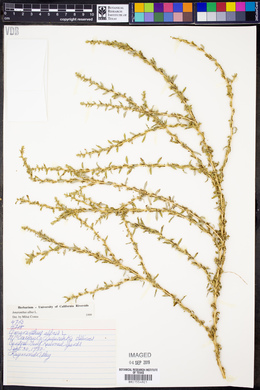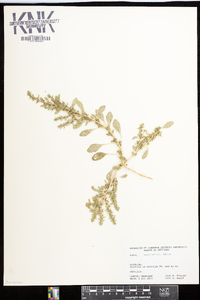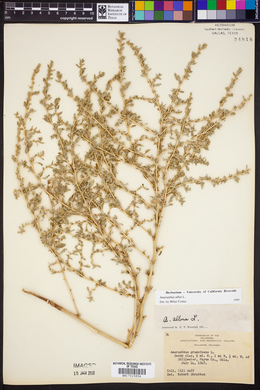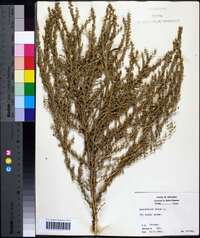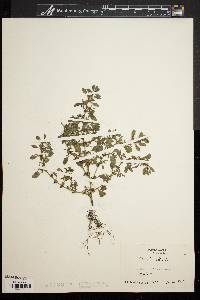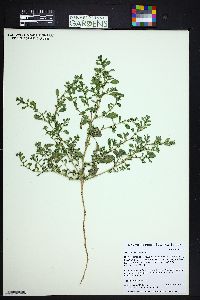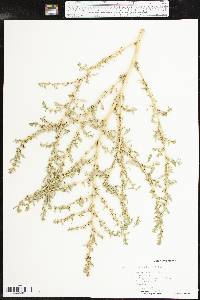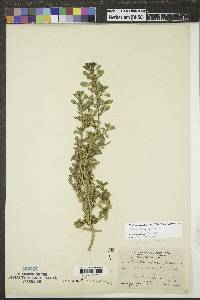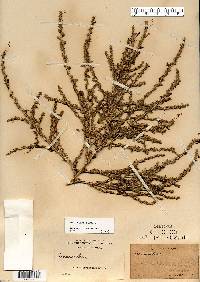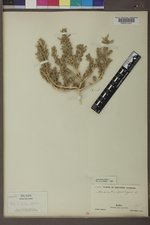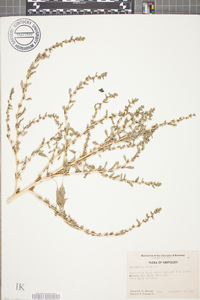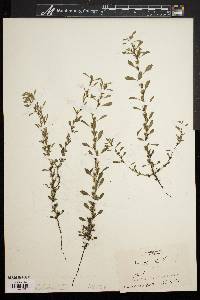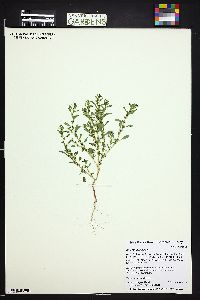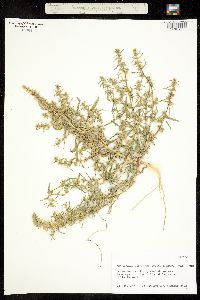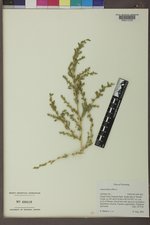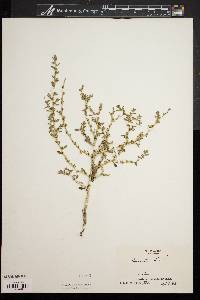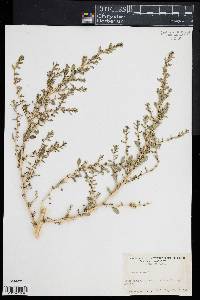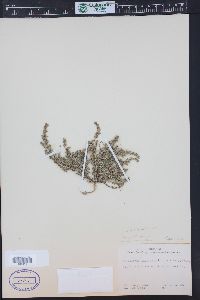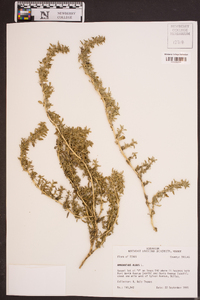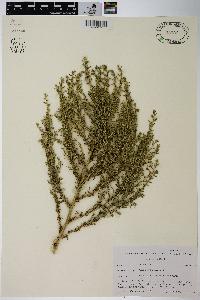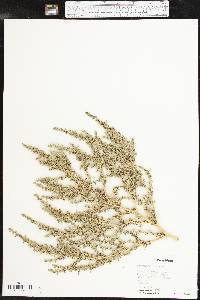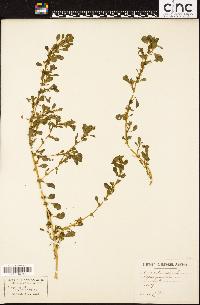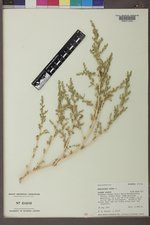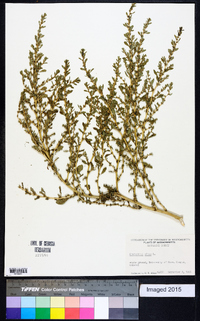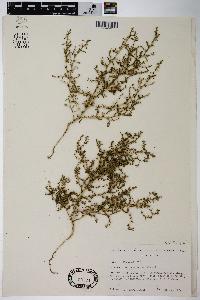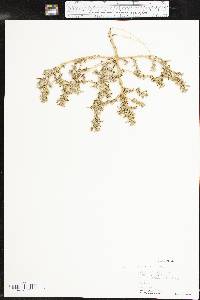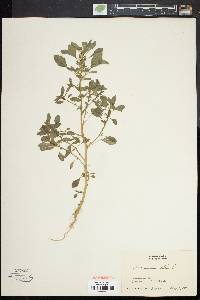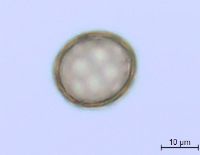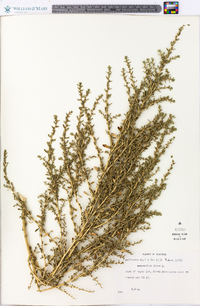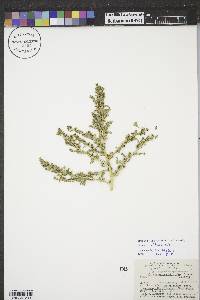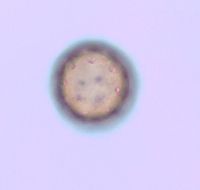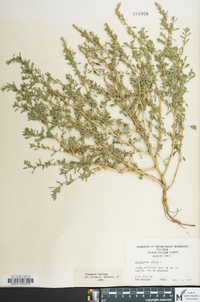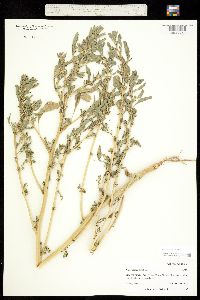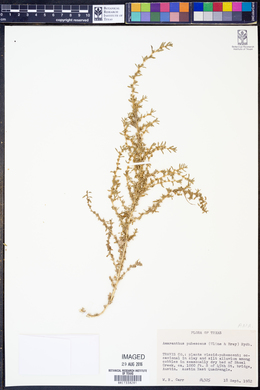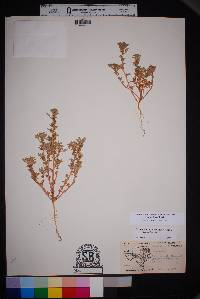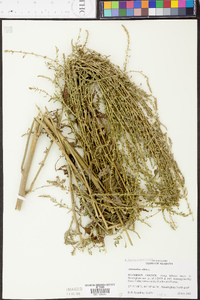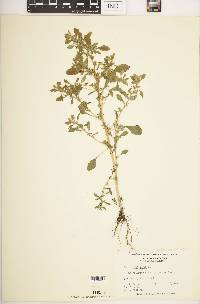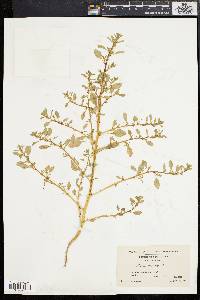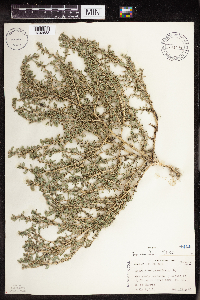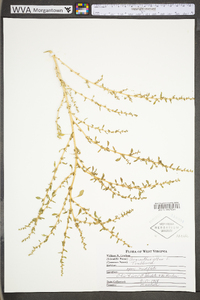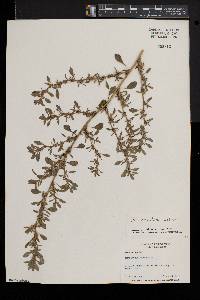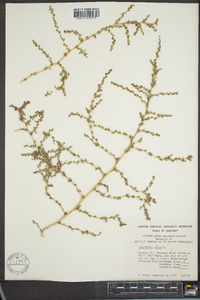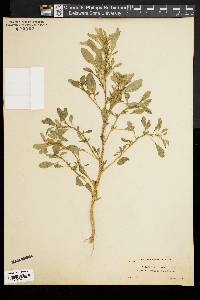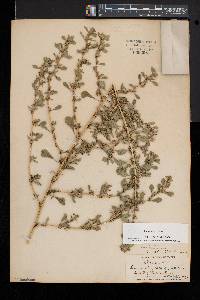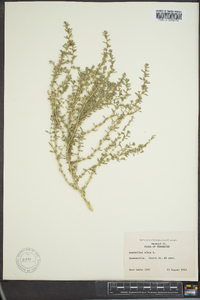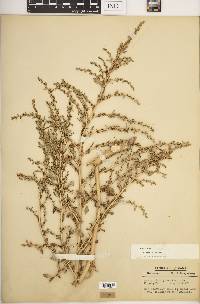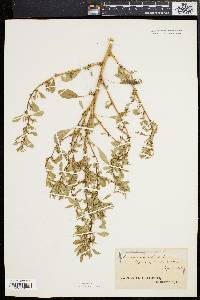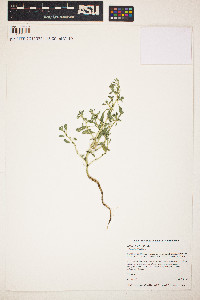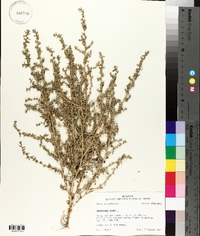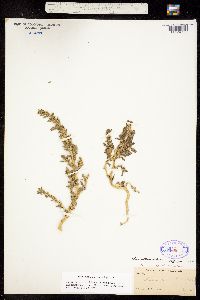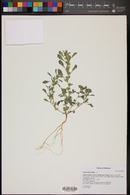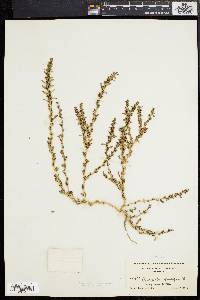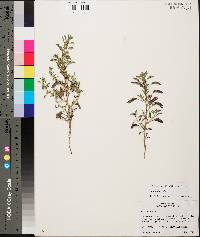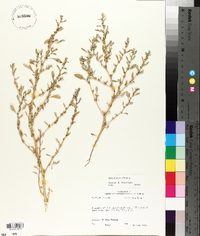
|
|
|
|
Family: Amaranthaceae
Tumbleweed
[Amaranthus albus var. pubescens (Uline & Bray) Fern., moreAmaranthus graecizans subsp. sylvestris (Vill.) Brenan, Amaranthus graecizans var. pubescens Uline & Bray, Amaranthus pubescens (Uline & Bray) Rydb.] |
Plants annual, glabrous or glabrescent or viscid-pubescent. Stems usually erect, ascending proximally, rarely almost prostrate, much-branched, bushy (large plants forming tumbleweeds), 0.1-1 m. Leaves: petiole 1/2 as long as blade, or longer in young proximal leaves; blade obovate to narrowly spatulate, mostly 0.5 × 0.5-1.5 cm, early proximal leaves to 8 cm, base tapering, narrowly cuneate, margins entire, plane (or ± distinctly undulate), apex obtuse, with whitish or yellowish, subspinescent mucro. Inflorescences axillary glomerules, green, whitish green, or yellowish. Bracts of pistillate flowers subulate to linear-lanceolate, narrow, 2-3 mm, 2 times as long as tepals. Pistillate flowers: tepals 3, narrowly ovate to linear, slightly unequal, 1-1.5 mm, thin, apex acute; style branches erect; stigmas 3. Staminate flowers intermixed with pistillate; tepals 3; stamens 3. Utricles ellipsoid-ovoid, 1.5 mm, equaling or exceeding tepals, smooth proximally, coarsely rugose distally, dehiscence regularly circumscissile. Seeds dark reddish brown to black, lenticular, 0.6-1 mm diam., shiny. Flowering summer-fall. Disturbed habitats, waste places, vacant areas, railroads, streambanks, sandy areas, roadsides, agricultural fields; 0-2200 m; introduced; St. Pierre and Miquelon; Alta., B.C., Man., N.B., Nfld. and Labr., N.S., Ont., P.E.I., Que., Sask.; Ala., Alaska, Ariz., Ark., Calif., Colo., Conn., Del., D.C., Fla., Ga., Idaho, Ill., Ind., Iowa, Kans., Ky., La., Maine, Md., Mass., Mich., Minn., Miss., Mo., Mont., Nebr., Nev., N.H., N.J., N.Mex., N.Y., N.C., N.Dak., Ohio, Okla., Oreg., Pa., R.I., S.C., S.Dak., Tenn., Tex., Utah, Vt., Va., Wash., W.Va., Wis., Wyo.; Mexico; introduced and often successfully naturalized in South America, Eurasia, Africa, Australia. The name Amaranthus graecizans, which refers to a species of Old World origin, has been misapplied to both A. albus and A. blitoides in earlier North American floras and manuals. Southwestern plants differing from typical Amaranthus albus in having viscid pubescence and usually distinctly crisped leaf margins may be recognized as var. pubescens; they were occasionally treated as a separate species, A. pubescens. Amaranthus albus and A. blitoides are rather often confused in herbaria. The species are easily distinguished by their seed size and luster.
FNA 2003, Kearney and Peebles 1969, Wiggins 1964, Heil et al 2013 Duration: Annual Nativity: Native Lifeform: Forb/Herb General: Monoecious annual herb, glabrous or glabrescent or viscid-pubescent; stems usually erect, rarely prostrate, much-branched. Plants bushy (large plants forming tumbleweeds); up to 1 m tall, stems whitish in color. Leaves: Alternate, petiole half as long as blade, or longer in young proximal leaves; blade obovate to narrowly spatulate with a tapering or cuneate base, margins entire to crispate-undulate, apex obtuse with whitish or yellowish subspinescent mucro. Leaves mostly small, 3 cm long by 1 cm wide, but early leaves are larger, up to 8 cm. Flowers: Inflorescences are axillary glomerules with male and female flowers intermixed. Flowers green, whitish green or yellowish; bracts of pistillate flowers 2-3 mm, twice as long as tepals, with stout-, long-acuminate, spinescent apices; pistillate flowers with 3 tepals slightly unequal in length, style branches erect; 3 stigmas; Staminate flowers with 3 tepals, 3 stamens. Fruits: Utricles ellipsoid-ovoid, 1.5 mm, equaling or exceeding tepals, smooth proximally, coarsely rugose distally, dehiscence regularly circumscissile with dark reddish brown to black lenticular seeds, 0.6-1 mm diameter and shiny. Ecology: Common agricultural weed. Found on disturbed sites, along roads, and in fields from 1,500-8,000 ft (457-2438 m); flowers June-October. Distribution: Widespread and weedy species that ranges all across the United States and into Mexico. Especially common in the West. USDA PLANTS lists this species as introduced to North America, but several other sources list the species as native. Heil et al (2013) states that the species is probably native to central and western North American and is adventive elsewhere. Notes: Confusingly, the USDA PLANTS database lists the common name for this species as "prostrate pigweed"- even though the growth form is most often erect and bushy. This erect, tumbleweed-like growth form and generally more whitish stems help to separate this species from others in the genus. Also look for the often crispate (wavy) leaf margins. Ethnobotany: Uses are recorded for the Chiricahua Apache, Mescalero Apache, Navajo, and Hopi. Used to make flour and bread, the greens were prepared with meat, the seeds were used for other types of food, and it had some ceremonial uses. Etymology: Amaranthus comes from the Greek amarantos, "unfading," referring to the long-lasting flowers; albus means white. Synonyms: Amaranthus albus var. pubescens, Amaranthus graecizans, Amaranthus graecizans var, pubescens, Amaranthus pubescens Editor: SBuckley, 2010, AHazelton 2015, AHazelton 2017 Monoecious; bushy-branched, to 1 m high and wide, the stems whitish; lvs of flowering branches elliptic to oblong or obovate, 0.5-3 mm, pale green, obtuse or rounded, attenuate to a long petiole; early lvs often to 8 cm; fls in short, dense, axillary clusters; bracts rigid, subulate, 2-3 times as long as the fls; sep 3, with simple midvein, those of the pistillate fls straight, acutish, unequal, the longest nearly equaling the fr; stamens 3; style-branches very short, erect; fr lenticular, 1.3-1.7 mm, rugulose when dry, circumscissile at the middle; seed suborbicular, 0.7-1 mm; 2n=32. Fields and waste ground; native to the prairies and plains of c. N. Amer., now a weed throughout our range and elsewhere. (A. graecizans, misapplied) Gleason, Henry A. & Cronquist, Arthur J. 1991. Manual of vascular plants of northeastern United States and adjacent Canada. lxxv + 910 pp. ©The New York Botanical Garden. All rights reserved. Used by permission. From Flora of Indiana (1940) by Charles C. Deam An infrequent weed throughout the state. It prefers a dry, sandy soil, hence is much more frequent in the northern part of the state. It is most commonly found in sandy waste places, gravel pits, and cultivated fields and along roadsides and railroads. ...... Indiana Coefficient of Conservatism: C = 0 Wetland Indicator Status: FACU Diagnostic Traits: plants erect, stems whitish; flowers in small axillary clusters, monoecious; bracts subulate, much longer than the tepals; tepals 3; fruit cross-wrinkled, their seeds up to 1.0 mm. |
|
|
|
This project was made possible in part by the Institute of Museum and Library Services [MG-70-19-0057-19].
Powered by Symbiota

